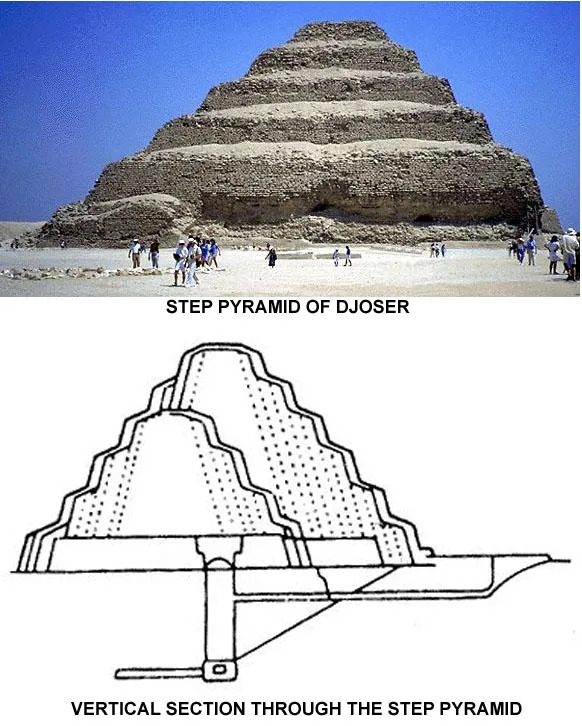If you want to know about the Roman architecture or Greek architecture or Indus valley civilization, please click the link.
Egyptian architecture is a rich and varied architectural style that has evolved over thousands of years. It is best known for its iconic pyramids, monumental temples, and elaborate tombs, as well as its use of massive stone blocks, columns, and elaborate reliefs and paintings.
The ancient Egyptians built their pyramids, tombs, temples and palaces out of stone, the most durable of all building materials. Although earthquakes, wars and the forces of nature have taken their toll, the remains of Egypt’s monumental architectural achievements are visible across the land, a tribute to the greatness of this civilization.
These building projects took a high degree of architectural and engineering skill, and the organization of a large workforce consisting of highly trained craftsmen and laborers.
1) Introduction
- It involves the buildings, sculpture, painting and decorative arts of Ancient Egypt from about 5000BC to the conquest of Egypt by Rome in 30BC.
- Egyptian Architecture were made to serve a purely religious purpose. That is;
- Temples were decorated with paintings and filled with statues of gods and kings, in the belief that doing so served the gods and was a sign of devotion to the king.
- Palaces were built for the worship of the kings and to serve as his dwelling place as well as for public administration.
- Tombs were built to ensure the enjoyment of dead kings in their life after death.
- Jewelry and amulets (charms) were worn not only for decoration but as protection against harm.
- Therefore, architecture cannot be devoid of the culture and tradition of the people.
- Egyptian arts and architecture were not for all Egyptians but only for kings and members of the ruling elites, and also for the gods.
2) Architectural influences
Ancient Egyptian architecture was an offshoot of various environmental influences which include.
Historical
- Oldest and most ancient civilization.
- Social life in Egypt was determined by the dictatorial rule of the pharaoh (his court, officials and priesthood) at one end of the scale and the strenuously-toiling peasants at the other.
- He employed large staff of trained craftsmen and levied vast armies of labourers for the erection of monumental buildings primary of which is the pyramids.
- The labourers are probably motivated by a deep faith in the divinity of their leaders and a belief in immortality.
- They also thought that their contributions would improve their own prospects at the final judgment in the afterworld.
- Captives and foreigners were also employed in public works.
Religious
- There is a close connection between religion and architecture, for the priesthood was powerful, invested with unlimited authority and equipped with all the learning of the age.
- The traits of the Egyptian religious rites were reproduced in their architecture.
- There were cults of many gods representing natural phenomena and the heavenly bodies, such as the sun, moon and stars, and by the worship of animals as personification of gods.
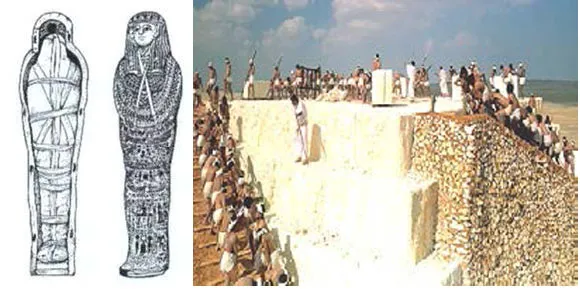
- They believed in life after death.
- Thus, they erected such everlasting monuments as pyramids for the preservation of the dead.
- The earthly dwelling residence was regarded as a temporary lodging, and the tomb as the permanent abode.
- The pharaohs were seen as gods divine representatives on earth.
- After death, they became immortal, joining the gods in the afterworld.
- Egyptians also believed that the body and soul were important to human existence, in life and in death e.g., their funerary practices, such as mummification and burial in tombs, were designed to assist the deceased find their way in the afterworld.
- Egyptians believed that only the souls of kings went on to enjoy life with the gods and not the souls of the nobles, which continued to inhabit the tomb and needed to be nourished by daily offerings of food and drink.
- To encourage the soul to return to the body, the body was preserved and a statuette in the likeness of the deceased was placed in the tomb.
- Statuettes called shabti or shawabti, (slaves for the soul) were also placed in the tombs to perform work on behalf of the deceased in the afterlife.
- The tombs were filled with food, tools, domestic wares, and treasures (all the necessities of life) to ensure the soul’s return to the body so that the deceased would live happily ever after.
Climatic
- Equable and warm i.e., no snow and frost; rainfall is rare; all these conditions contributed to the preservation of ancient Egyptian monuments.

a) Roof drainage was not an important consideration, thus flat roofs of stones were used to cover the buildings, excluding the intense heat in the process.
b) No real need for windows, thus massive walls were used.
c) The massive walls also protect the interior from the fierce heat of the sun, and It provided an uninterrupted surface for hieroglyphics
d) Brilliant sunshine enabled sufficient light to reach the interior of temples through doors and roof slits.
Geographical
- Egypt is situated along the banks of the Nile River which divides to form outlets to the Mediterranean Sea at the north and to the Red Sea at the east.
- The two seas served as inlets and outlets for both western and foreign trade, and as an unfailing means of communication.
- The Nile turns desert sands into fruitful fields for a predictable agricultural system, thus it afforded a stability of life in which arts and crafts readily flourished.
- Therefore, the banks of the Nile River became the site of their villages, cities and cemeteries.
- Equally, the deserts and the seas, which protected Egypt on all sides, contributed to its stability by discouraging serious invasion for almost 2000 years.
Geological
Building materials that were abundantly available in Egypt are:
- Stone
- People live in river mud houses except in rare cases of stone being more readily available.
- Even pharaohs lived in brick palaces and rock was reserved for the dead and the gods.
- Egyptian monuments have remained lasting largely due to the durability of the materials.
- Egyptian architecture was made possible not only by the materials, but also by the methods of quarrying, transporting and raising enormous blocks of stone into position.
- Sun-dried Bricks
- Tombs and temples were constructed of stone while domestic buildings were built with sun-dried bricks.
- The sun-dried bricks were strong and lasting.
- The bricks were 300-450mm in length and 150-200mm in width.
- Five days’ work would make about 5000 bricks needed for a worker’s one storey house of 60-80m² with 400mm thick walls.
- Reeds and Palm-leaves
- Used to frame or reinforce mud-brick constructions (wattle and daub), or as mats for panels, partitions and fences.
- Mortar
- The ancient Egyptians did not know the hard setting lime plaster invented by the Greeks but used instead a mixture of gypsum and quartz with small amounts of lime.
- Wood
- Doors and shutters were made of it and upper storey floors.
- The longest beams that could be cut from local wood were only three to four meters long.
- If the ceiling was wider than that, it had to be supported with wooden pillars.
- When a building was abandoned, all wooden and stone parts were removed to be reused somewhere else.
3) Architectural character
Description
- Domestic architecture consisted of papyrus and palm-branch ribs, plastered over with clay.
- Wall or fences were made by stacking vertically, bundles of stems side by side, tied together by another bundle placed horizontally near the top.
- Alternatively, palm-leaf ribs were planted in the ground at short intervals, with others laced in a diagonal network across them, and secured to a horizontal member near the top; the whole being daubed with mud afterwards.
- Sun-dried mud bricks were also used as walling material.
- The walls were made to diminish course by course towards the top for stability.
- The inner face of the wall remained vertical for ordinary convenience, while it was the outer face which tapered upwards.
- Vaulting was introduced but never used in monumental stonework till the advent of the Romans.
- Egyptian columns have a distinctive character derived from vegetable origin; their shafts indicative of bundles of plant stems, gathered-in a little at the base, and with capitals seemingly derived from the lotus bud, the papyrus flower or the ubiquitous palm.
- Egyptian monumental architecture is essentially a columnar and trabeated style.
Roof & openings
- Roof was not an important consideration
- Flat roofs sufficed to cover and exclude heat
- No windows
- Spaces were lit by skylights, roof slits, clerestories
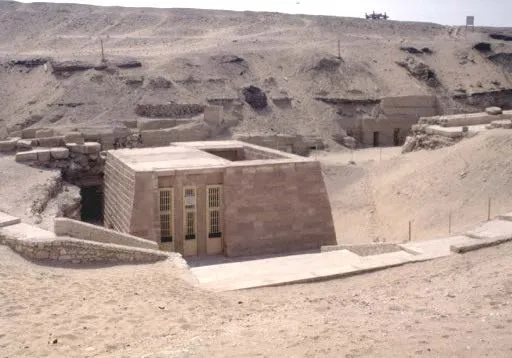
Wall
- Batter wall – diminishing in width towards the top for stability
- Thickness: 9 to 24m at temples
- Unbroken massive walls, uninterrupted space for hieroglyphics
Decorations
- Mouldings such as “gorge” or “hollow and roll” was inspired by reeds
- Torus moulding
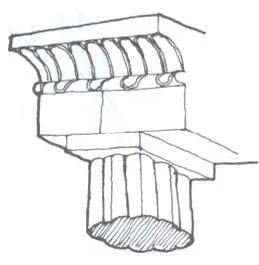
- Hieroglyphics were pictorial representations of religion, history and daily life
- Derived from the practice of scratching pictures on mud-plaster walls
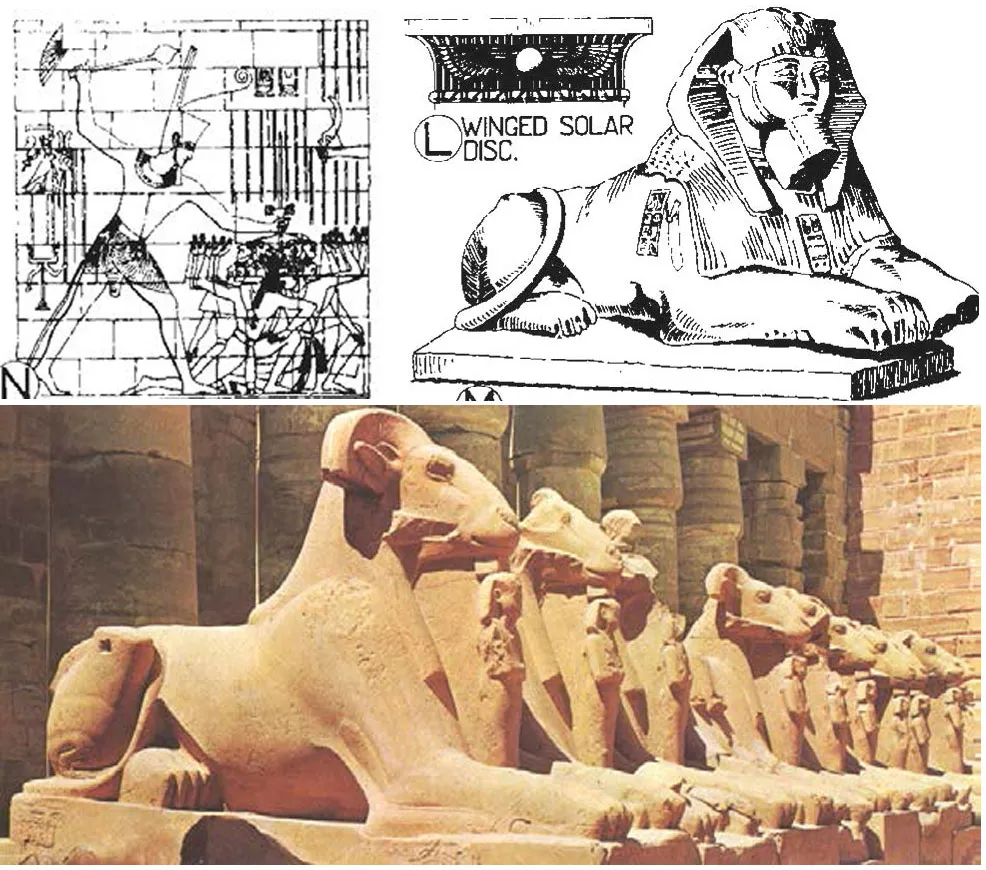
- Avenue of sphinxes: rows of monsters (body of lion, head of man, hawk, ram) leading to monuments
- Common ornaments:
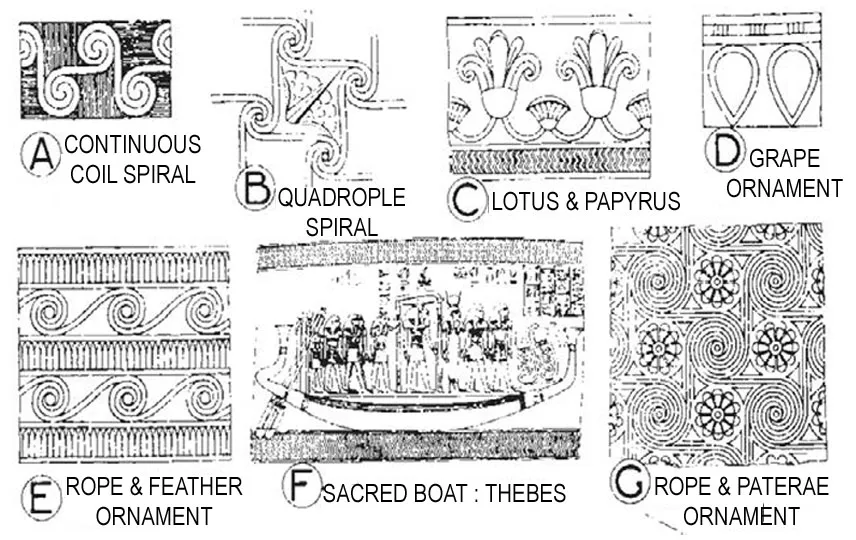
- Common capitals used were the lotus, papyrus, palm which echoed indigenous Egyptian plants, and were symbols of fertility as well
- The shaft represented bundle of stems
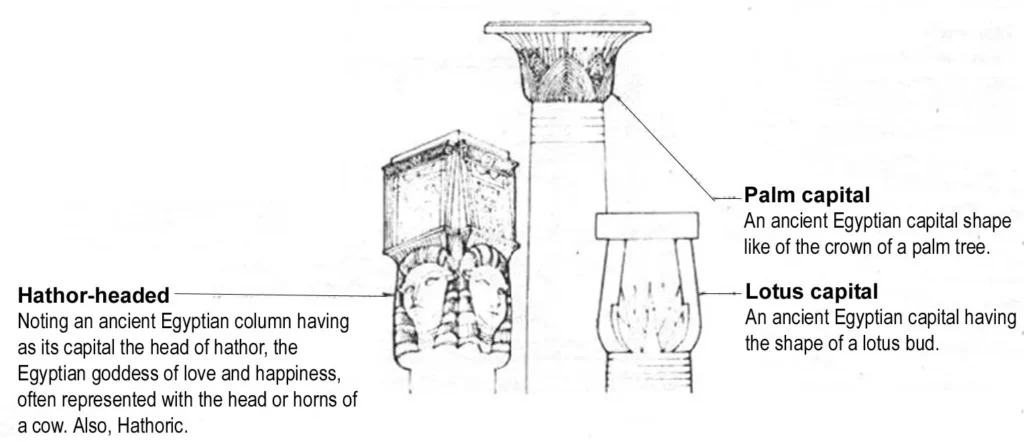
4) Architectural typology
Three principal building types: tomb, temple and domestic architecture.
A) Tomb Architecture
- Highly developed and often grandiose.
- The tomb not only protected the corpse from desecration but also provided it with materials to ensure continued existence after death.
- Tombs were of three main types namely; Royal pyramids, Private tombs (tombs of the elites) and Rock-cut tombs.
i) Royal Pyramids
The royal pyramids were elaborate structures with important religious purposes such as:
- Belief in life after death: they use every means at their disposal to build lasting tombs, to preserve the body, and to bury with it the finest commodities that might be needed for the sustenance and eternal enjoyment of the deceased.
- Located on the west side of the Nile River: Because the sun sets in the west, Egyptians believed that to be the entrance to the world where the dead dwells.
- Orientation of the pyramids is east – west which paralleled the day time course of the sun as it rises and sets.
- Height of the pyramid was meant to take away the breath of the onlooker and cause him to tremble and to impress them with the ruler‟s god-like strength.
- The gigantic pyramids were conspicuous targets for tomb robbers.
- Therefore, generations of kings hid their tombs in the Valley of the Kings in an attempt to elude the robbers.
- Despite efforts to hide the entrances, thieves managed to find the tombs, pillaging and emptying them of their treasures, jeopardizing the hope for eternal life.
- The tombs consisted of a series of corridors, steps and rooms that ended in a burial chamber.
- The door from the tomb formed a point of transition from the world of the living to the world of the dead.
- A stelae marked the entrance of the tomb and bore the name of the royal occupant.
Stages of Evolution of Egyptian Tomb Architecture
- 1st Dynasty Kings ( 2920 – 2770 BC ) were buried in cemeteries built of sun-dried mud bricks (mastabas).
- The first pyramid (Step pyramid) was introduced during the 3rd Dynasty of kings ( 2649 – 2575BC ) by Architect Imhotep and was built of stone for King Djoser (Zoser).
- It consisted of six huge, square tiers (steps) of decreasing size, placed one on top of each other to a height of 60 meters.
- Similarities show that the step pyramidal tomb is an elaboration of the original mastaba tomb type.
- The most monumental of the royal pyramids are: the Step Pyramid of Djoser, Saqqara and the Three Pyramids of Giza.
